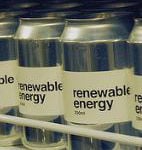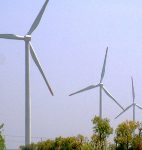China is already a leading force in the low-carbon economy, says a new report [pdf] from the Climate Group.
The study, titled China’s Clean Energy Revolution II: Opportunities for a Low Carbon Future, claims that “China’s businesses have already become global leaders in a range of low-carbon products and services, particularly the renewable energy sector.”
[Editor’s note: this quotation and some of the other selections below do not appear in the English version of the report, but have been translated into English from the Chinese version [pdf].]
“[I]n an incredibly short space of time China has taken the lead in the race to develop and commercialize a range of low carbon technologies,” says the English-language press release.
There is a global consensus that addressing climate change requires a transition to a low-carbon economy; this is the focus of the latest round of international economic competition. And for a long time, China was at the back of the pack, much as it is in the men’s 100-metres sprint. So, has China now produced an overnight miracle – and become the Usain Bolt of the low-carbon race? Unfortunately, it seems to me that it has not.
According to the report, China’s low-carbon leadership is best demonstrated in the renewable-energy sector, such as wind and solar power. Of these, wind power performs best. In less than eight years, China’s wind power generating capacity has passed 12 million kilowatts, overtaking India to become the largest wind-power generator in Asia. China’s installed wind power capacity is set to overtake that of Spain and Germany next year, putting it second in the world only to the United States.
However, the technical and market weaknesses behind these successes are hard to conceal. Wind power in China is not developing well, a fact that the industry is well aware of.
A year before the Climate Group report, China’s State Electricity Regulatory Commission (SERC) published its own survey of the state of China’s wind-power sector. The research was carried out by experts at the Chinese Academy of Sciences and the China Electric Power Research Institute, who confirmed that progress has been made by the wind power sector, but also expressed concerns: China’s research, development and innovation in wind turbine technology lags far behind other countries, and there have only been certain limited advances in the selection of materials and some technical issues. China lacks the technology and staff it needs to master turbine design: the country still relies on imports of key components, such as transformers, bearings and blades. In other words, China’s wind turbine manufacturers are little more than assembly workshops for foreign companies.
Moreover, there are quality and reliability issues associated with the turbines assembled by Chinese firms; the availability ratio for Chinese turbines is lower than the equivalent foreign machines. Even the Climate Group report notes this technology gap faced by domestic firms. For example, Goldwind, China’s leader in turbine manufacturing, “spends the bulk of its research-and-development funds on prototype turbines, and 90% of that is spent procuring imported components.”
The solar energy sector, which the report sees as strong, does not give much cause for optimism either.
China has become the world’s largest exporter of photovoltaic (PV) cells. At the United Nations climate-change talks in Bali in 2007, Alexander Karsner, then US assistant secretary of energy, used the Jiangsu-based company Suntech as an example of China’s advances in low-carbon technology, calling into question the country’s demands for technology transfer from developed nations.
But Suntech’s success does not mean China is a leader in solar-power generation. As the Climate Group report says, “most Chinese PV enterprises are in the mass production category, where the technology is not advanced.” In the production of polycrystalline silicon, which is at the higher end of the PV industrial chain, China’s manufacturers still rely on imports of key technologies and equipment.
Some of these firms are even dumping poisonous silicon tetrachloride, a by-product of the manufacturing process, a practice that casts a shadow over the whole “clean” industry. It is a phenomenon described by some as “spending abroad, polluting at home.”
Recent years have seen both wind and solar power become favourites for investors; many local government officials see new energy as a way to boost their careers. But rapid development can obscure problems. China has failed to develop the grid to keep up with wind power expansion, meaning that electricity cannot be transmitted to other places. Inner Mongolia, in north-west China, has three million kilowatts of wind power capacity, but no way to get that power to the rest of the country. The SERC report also notes that errors in evaluating wind resources, poor positioning of wind farms and incorrect selection of equipment mean that many wind farms struggle to survive, or even operate at a loss.
The Chinese government is already aware that the solar and wind power sectors are “overheating”. On August 26, the State Council pointed out there is a tendency to duplicate capacity in new industries, such as wind power and polysilicon. The real winners in these “Great Leaps Forward” have been overseas turbine manufacturers and polysilicon equipment providers. They struck gold in China’s low-carbon markets, but China does not have the advanced technology it wants.
It is not a bad thing for China to focus on developing wind and solar power, but this needs to be done rationally, with an emphasis on technical innovation and efficiency. It is also crucial to note that the low-carbon economy is not limited to wind and solar power. In the long-term, coal will remain China’s major source of power. Increasing the efficiency of coal use and developing clean-coal technology should be at the heart of decarbonising China’s economy.
However, these pose significantly more difficulties than simply building new wind farms – and there will not be the same opportunities for advancement for local government officials. China’s low-carbon economy will also be enhanced by reducing energy consumption and emissions from buildings and transportation. In these areas, China is still far from a world leader.
In fact, the Climate Group is clear on some of the challenges that China’s low-carbon economy faces. It will depend “in great part” on policy direction, the report says. “It should also be clear that a simple reliance on administrative measures to promote the low-carbon economy will lead to a long term lack of impetus. If future policy focuses more on overall strategic coordination; on sustainability and implementability; encouraging the research, development and popularization of technology; and using market methods to adjust and promote innovation in commercial models and financing methods – then the low carbon economy will grow more quickly and more stably.”
Recent years have seen some progress towards a low-carbon economy, but there is a long way to go before China becomes the low-carbon Usain Bolt.
Li Taige is a Beijing-based journalist. He obtained a masters degree in engineering from Sichuan University in 1997, and studied as a Knight Science Journalism Fellow at the Massachusetts Institute of Technology (MIT) in 2003-2004.
Homepage image by Greenpeace / Xuan Canxiong


